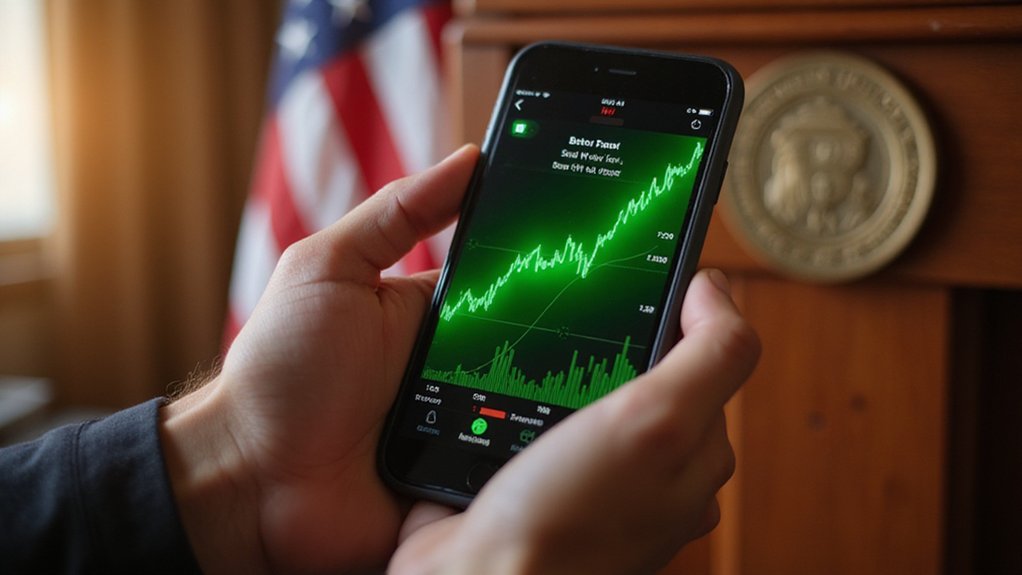Bitcoin ETF inflows represent institutional conviction beyond mere speculation, with BlackRock’s IBIT achieving a remarkable 19-day streak through May 9. These flows function as momentum indicators rather than direct price drivers, particularly evident during Bitcoin’s journey beyond $100,000. Investors strategically accumulate during price consolidations, targeting the $62,000-$63,000 range as prime entry points. The transformation from “tulip bulb” dismissals to standard portfolio component signals a fundamental recalibration in digital asset perception. The patterns offer invaluable signals for those positioning amid market sentiment shifts.

While the global financial markets continue to navigate uncertain waters, Bitcoin ETFs have emerged as beacons of extraordinary momentum, extending their remarkable inflow streaks well into 2025. BlackRock’s IBIT ETF, the behemoth among its peers, recently achieved an unprecedented 19-day consecutive inflow streak through May 9—a proof to the voracious institutional appetite that shows little sign of abating despite Bitcoin’s meteoric rise beyond the once-fantastical $100,000 threshold.
The approval of spot Bitcoin ETFs in January 2024 irrevocably altered the cryptocurrency investment landscape, offering institutions a regulated vehicle through which to gain exposure without the operational complexities of direct custody.
This regulatory benediction has catalyzed the broader ETF market’s record-breaking performance, contributing substantially to the staggering $620.54 billion in net inflows during 2025’s first quadrimester.
The May 14 single-day influx of $319.5 million—a figure that would have seemed hallucinatory mere years ago—underscores not merely speculative fervor but calculated institutional conviction.
The relationship between ETF inflows and Bitcoin’s price action, however, remains deliciously complex.
While correlation often manifests during volatility spikes (as evidenced during Bitcoin’s six-figure debut), these capital flows function more as momentum indicators than pure price determinants. The Grayscale Bitcoin Mini Trust ETF has particularly demonstrated this trend with $435 million YTD net new assets by April 2025.
Sophisticated investors increasingly view certain price consolidations as accumulation opportunities, deploying capital strategically during perceived lulls in anticipation of subsequent appreciation.
For the discerning investor, these sustained inflows signify more than mere market participation; they represent a fundamental recalibration of institutional sentiment toward digital assets. This institutional embrace could expand to other cryptocurrencies, with analysts projecting Litecoin ETF approval at a 90% likelihood this year following the regulatory precedent established by Bitcoin ETFs.
The transparency and familiar structure of ETFs—essentially rendering the exotic comprehensible through conventional financial architecture—have transformed Bitcoin from pariah to portfolio component for wealth managers who previously dismissed it with intellectual hauteur¹.
As Bitcoin continues its institutionalization process, these inflow patterns offer valuable signals regarding market sentiment.
Institutional investors have demonstrated strong confidence by viewing the $62,000-$63,000 range as a prime accumulation zone for building positions.
The persistent capital deployment suggests not ephemeral speculation but rather calculated positioning for what many institutions now view as an inevitable component of tomorrow’s financial ecosystem.
¹A remarkable reversal from the “tulip bulb” dismissals that dominated institutional discourse merely half a decade ago.
Frequently Asked Questions
How Do Bitcoin ETFS Affect Cryptocurrency Market Volatility?
Bitcoin ETFs affect cryptocurrency market volatility through multiple mechanisms.
Initially, their approval process generates speculative trading that amplifies price swings.
Post-approval, these instruments can paradoxically both increase volatility (through expanded access and options trading) and decrease it (via institutional participation and market maturation).
Redemption patterns, hedge fund positioning, and shifting market sentiment create additional volatility vectors—though the long-term trend suggests ETFs may ultimately domesticate Bitcoin’s notorious price gyrations as market integration deepens.
What Are the Tax Implications of Investing in Bitcoin ETFS?
Bitcoin ETF investments carry the typical capital gains tax burden, with rates contingent on holding periods—long-term (>1 year) offering preferably lower rates (0-20%) than their short-term counterparts (ordinary income rates).
Structured as grantor trusts, these ETFs pass tax reporting responsibilities to investors via Form 1099-DIV.
Tax-conscious investors might consider strategies like tax-loss harvesting or utilizing tax-deferred accounts—though the IRS’s penchant for cryptocurrency scrutiny suggests professional guidance remains prudent for this emerging investment vehicle.
Can Bitcoin ETFS Be Included in Retirement Accounts?
Yes, Bitcoin ETFs can indeed be included in retirement accounts, offering investors a regulated avenue to cryptocurrency exposure without the complexities of direct ownership.
While most tax-advantaged retirement providers accommodate these instruments, institutional support varies considerably—a fact perhaps worth investigating before enthusiastic portfolio adjustments.
Though the Department of Labor has expressed reservations about crypto investments in retirement plans, neither the IRS nor ERISA explicitly prohibits Bitcoin ETFs in IRAs, provided fiduciary obligations are satisfied.
How Do Bitcoin ETF Fees Compare to Direct Cryptocurrency Ownership?
Bitcoin ETF fees typically range from 0.19% to 1.5% annually, accumulating over time and potentially eroding returns—a recurring toll on one’s portfolio that direct ownership neatly sidesteps.
Instead, cryptocurrency holders pay one-time transaction fees and optional storage costs.
While ETFs offer convenience (and those professional management credentials that supposedly justify their price tags), direct ownership presents a more cost-effective long-term proposition for investors willing to navigate the admittedly steeper learning curve.
What Regulatory Risks Could Impact Bitcoin ETF Performance?
Regulatory risks hovering over Bitcoin ETFs include potential SEC rule changes, inconsistent global regulatory frameworks, and shifting tax implications—all of which could dramatically alter fund operations overnight.
The specter of enhanced KYC/AML requirements, unexpected trading restrictions, or outright bans in certain jurisdictions looms large.
Perhaps most concerning is the regulatory limbo itself; uncertainty about future oversight can trigger market volatility as institutional investors recalibrate positions based on whispers of regulatory winds changing direction.









